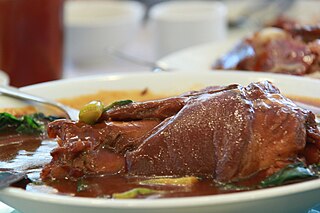
Satay, or sate in Indonesian spelling, is a Southeast Asian form of kebab made from seasoned, skewered and barbecued meat, served with a sauce.

Filipino cuisine is composed of the cuisines of more than a hundred distinct ethnolinguistic groups found throughout the Philippine archipelago. A majority of mainstream Filipino dishes that compose Filipino cuisine are from the food traditions of various ethnolinguistic groups and tribes of the archipelago, including the Ilocano, Pangasinan, Kapampangan, Tagalog, Bicolano, Visayan, Chavacano, and Maranao ethnolinguistic groups. The dishes associated with these groups evolved over the centuries from a largely indigenous base shared with maritime Southeast Asia with varied influences from Chinese, Spanish, and American cuisines, in line with the major waves of influence that had enriched the cultures of the archipelago, and adapted using indigenous ingredients to meet local preferences.

Bistek, also known as bistek tagalog or karne frita, is a Filipino dish consisting of thinly-sliced beefsteak braised in soy sauce, calamansi juice, garlic, ground black pepper, and onions cut into rings. It is a common staple in the Tagalog and Western Visayan regions of the Philippines. It is eaten over white rice.

Barbecue varies by the type of meat, sauce, rub, or other flavorings used, the point in barbecuing at which they are added, the role smoke plays, the equipment and fuel used, cooking temperature, and cooking time.

Longaniza is a Spanish sausage (embutido) similar to a chorizo and also closely associated with the Portuguese linguiça. Its defining characteristics are interpreted differently from region to region. It is popular in the cuisines of several regions of Spain, Argentina, Uruguay, Puerto Rico, Dominican Republic, El Salvador, Guatemala, Mexico and Chile. In the Philippines, it is called longganisa and has hundreds of variants with different vernacular tastes and forms due to the 144 ethno-linguistic groups of the archipelago. Longaniza essentially tracks the spread of Latin culture around the world. Longaniza derives from Lucanica, a sausage from Lucania in Southern Italy that was adopted by the Latins of Ancient Rome through military contact. From there it spread to Spain, and from Spain, centuries later, to every place in the world with modern "Latin" culture.

Philippine adobo is a popular Filipino dish and cooking process in Philippine cuisine. In its base form, meat, seafood, or vegetables are first browned in oil, and then marinated and simmered in vinegar, salt and/or soy sauce, and garlic. It has occasionally been considered the unofficial national dish in the Philippines.

Inihaw, also known as sinugba or inasal, are various types of grilled or spit-roasted barbecue dishes from the Philippines. They are usually made from pork or chicken and are served on bamboo skewers or in small cubes with a soy sauce and vinegar-based dip. The term can also refer to any meat or seafood dish cooked and served in a similar way. Inihaw are commonly sold as street food and are eaten with white rice or rice cooked in coconut leaves (pusô). Inihaw is also commonly referred to as Filipino barbecue or (informally) Pinoy BBQ.

Humbà, also spelled hombà, is a Filipino braised pork dish from Visayas, Philippines. It traditionally uses fatty cuts of pork belly slow-cooked until very tender in soy sauce, vinegar, black peppercorns, garlic, bay leaves, and fermented black beans (tausi) sweetened with muscovado sugar. It also commonly includes hard-boiled eggs and banana blossoms.

Pinatisan is a Filipino cooking process consisting of meat braised in patis, garlic, ginger, onion, black peppercorns, and bay leaves. Some recipes also add non-traditional ingredients like tomatoes, chili peppers, and other herbs and spices. Vinegar may also be added. It is very similar to binagoongan, which is made using fermented shrimp. It is also similar to Philippine adobo and paksiw, but is distinguished by the primary use of fish sauce in place of vinegar. Pinatisan has a strong umami flavor rather than the characteristic sour and sweet flavor of adobo.

Embutido, or embotido, is a Philippine meatloaf made with ground pork and stuffed with hard-boiled eggs and sliced ham or various sausages. It is traditionally wrapped in aluminum foil and steamed, though it can also be baked.

Morcón or morconito, is a Philippine braised beef roulade made with beef flank steak stuffed with hard-boiled eggs, carrots, pickled cucumber, cheese, and various sausages. It is commonly served during Christmas and other festive occasions.

Afritada is a Philippine dish consisting of chicken, beef, or pork braised in tomato sauce with carrots, potatoes, and red and green bell peppers. It is served on white rice and is a common Filipino meal. It can also be cooked with seafood.

Pininyahang manok, commonly anglicized as pineapple chicken, is a Philippine dish consisting of chicken braised in a milk or coconut milk-based sauce with pineapples, carrots, potatoes, and bell peppers. Some variants of the dish use a chicken stock base instead of milk. The dish originates from Southern Luzon which was once a regional center of pineapple fiber production in the Spanish Philippines.

Pata tim, also spelled patatim, is a Filipino braised pork hock dish slow-cooked until very tender in soy sauce, black peppercorns, garlic, bay leaves, and star anise sweetened with muscovado sugar. It also commonly includes péchay and mushrooms. The dish is commonly served in regions in the Philippines with large Chinese Filipino populations, especially in the Binondo district of Manila.

Binagoongan is a Filipino cooking process consisting of vegetables or meat sautéed or braised in bagoong alamang, garlic, black peppercorns, and bay leaves. Some recipes also add pineapples, chilis, or coconut cream to balance the flavors. The dish is characteristically quite salty with a strong umami flavor, which is why it is always paired with white rice and never eaten on its own. It is very similar to pinatisan which is cooked with patis, one of the by-products of fermenting bagoong.

Pampanga longganisa is a Filipino pork sausage originating from the province of Pampanga. It is a type of hamonado (sweet) longganisa. It is typically longer and thinner than other Philippine sausages. It is made with pork, garlic, brown sugar, black pepper, coarse salt, and vinegar. It can be prepared with or without the casing. It is typically dyed orange or red with achuete seeds. It is the most common sweet-type longganisa eaten throughout the Philippines, since it is commercially mass-produced.

Philippine asado refers to two different Filipino braised meat dishes. The name originates from Spanish asado ("grilled"), a reference to the original dish it was applied to, the Chinese-Filipino version of char siu barbecues usually known as pork asado. However, the Filipino versions have evolved to be braised, not grilled. The other Filipino dishes also known as asado are asado de carajay and asado matua. Unlike the Chinese-derived version, they are savory rather than sweet.

Pininyahang hipon, is a Filipino dish consisting of shrimp cooked in coconut milk, pineapples, tomatoes, onions, and various spices. It is a sweet variant of ginataang hipon. It is commonly cooked with leftover shrimp from halabos na hipon dishes.

Ginataang manok is a Filipino chicken stew made from chicken in coconut milk with green papaya and other vegetables, garlic, ginger, onion, patis or bagoong alamang, and salt and pepper. It is a type of ginataan. A common variant of the dish adds curry powder or non-native Indian spices and is known as Filipino chicken curry.
Binakol, also spelled binakoe, is a Filipino chicken soup made from chicken cooked in coconut water with grated coconut, green papaya, leafy vegetables, garlic, onion, ginger, lemongrass, and patis. It can also be spiced with chilis. Binakol can also be cooked with other kinds of meat or seafood. It was traditionally cooked inside bamboo tubes or directly on halved coconut shells. The dish originates from the Western Visayas, particularly the province of Aklan.






















